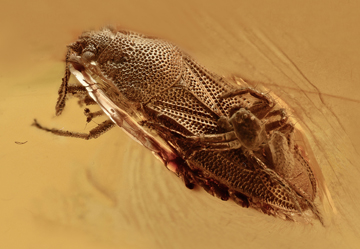Abstract
Lebanon is fascinating with its numerous Mesozoic amber outcrops. To date, 19 amber outcrops have been reported from the Kimmeridgian, Late Jurassic (Azar et al., 2010b; Nohra et al., 2013; Maksoud & Azar, 2020), and more than 430 from the lower Barremian (Garnier et al., 2016; Maksoud et al., 2017), Lower Cretaceous (Maksoud & Azar, 2020). This later number is still continuously growing, with to date 24 outcrops yielding biological inclusions (Maksoud et al., 2019, 2020). Lebanese amber is among the most important ambers as it documents the initial diversification of the extant entomofauna and the disappearance of some archaic insect groups (Azar, 1997, 2007, 2012; Azar & Nel, 1998; Azar et al., 2010a; Maksoud & Azar, 2020; Poinar & Milki, 2001).
References
Azar, D. (1997) A new method for extracting vegetal and insect fossils from the Lebanese amber. Palaeontology, 40, 1027–1029.
Azar, D. (2007) Preservation and accumulation of biological inclusions in Lebanese amber and their significance. Comptes Rendus Palevol, 6, 151–156.
https://doi.org/10.1016/j.crpv.2006.10.004
Azar, D. (2012) Lebanese amber: a “Guinness Book of Records”. Annales Universitatis Paedagogicae Cracoviensis, 111, 44–60.
Azar, D., Gèze, R. & Acra, F. (2010a) Chapter 14: Lebanese amber. In: Penney, D. (Ed.). Biodiversity of Fossils in Amber from the Major World Deposits. Siri Scientific Press, Manchester, pp. 271–298.
Azar, D., Gèze, R., El-Samrani, A., Maalouly, J. & Nel, A. (2010b) Jurassic amber in Lebanon. Acta Geologica Sinica - English Edition, 84, 977–983.
https://doi.org/10.1111/j.1755-6724.2010.00228.x
Azar, D. & Nel, A. (1998) Lebanese Lower Cretaceous amber. Meganeura, 2, 18–20.
Dubertret, L. (1945) Carte géologique au 50.000ème – Feuille de Zahlé. République Libanaise, Ministère des Travaux Publics, Beyrouth, 64 pp. + 13 pls. + map.
Dubertret, L. (1951) Carte géologique au 50 000ème – Feuille de Sir Ed Danié. République Libanaise, Ministère des Travaux Publics, Beyrouth, 51 pp. + 12 pls. + map.
Granier, B., Azar, D., Maksoud, S., Gèze, R. & Habchi, R. (2015) New fossiliferous sites with Barremian Charophyta in the «Grès du Liban» auct. (Lebanon), with a critical perspective regarding the nature of Munieria DEECKE, 1883. Carnets de Géologie, 15 (15), 199–229.
https://doi.org/10.4267/2042/57947
Granier, B., Toland, C., Gèze, R., Azar, D. & Maksoud, S. (2016) Some steps toward a new story for the Jurassic–Cretaceous transition in Mount Lebanon. Carnets de Géologie, 16 (8), 247–269.
https://doi.org/10.4267/2042/59924
Maksoud, S. & Azar, D. (2020) Lebanese amber: latest updates. Palaeoentomology, 3 (2), 125–155.
https://doi.org/10.11646/palaeoentomology.3.2.2
Maksoud, S., Azar, D, Granier, B. & Gèze, R. (2017) New data on the age of the Lower Cretaceous amber outcrops of Lebanon. Palaeoworld, 26 (2), 331–338.
https://doi.org/10.1016/j.palwor.2016.03.003
Maksoud, S., Taleb, K. & Azar, D. (2019) Four new Lower Barremian amber outcrops from Northern Lebanon. Palaeoentomology, 2 (4), 333–339.
https://doi.org/10.11646/palaeoentomology.2.4.6
Maksoud, S., Ziadé, K., Gèze, R. & Azar, D. (2020) New early Barremian amber outcrops from Central Lebanon. Palaeoentomology, 3 (4), 415–422.
https://doi.org/10.11646/palaeoentomology.3.4.14
Nohra, Y., Azar, D., Gèze, R., Maksoud, S., El-Samrani, A. & Perrichot, V. (2013) New Jurassic outcrops from Lebanon. Terrestrial Arthropod Reviews, 6, 27–51.
https://doi.org/10.1163/18749836-06021056
Poinar, G.O. & Milki, R. (2001) Lebanese amber: the oldest insect ecosystem in fossilized resin. Oregon State University Press, Corvallis, Oregon, 96 pp.


